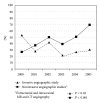Stroke care in young patients
- PMID: 23533963
- PMCID: PMC3600297
- DOI: 10.1155/2013/715380
Stroke care in young patients
Abstract
The aims of this study were (i) to evaluate the clinical features of a consecutive series of young patients with ischemic stroke and (ii) to assess the changes in the clinical management of these patients over the study period. All consecutive cases of young adults aged 16 to 44 years, with ischemic stroke, that were admitted between 2000 and 2005 in 10 Italian hospitals were included. We retrospectively identified 324 patients. One or more vascular risk factors were present in 71.5% of the patients. With respect to the diagnostic process, an increase in the frequency of cerebral noninvasive angiographic studies and a decrease in the use of digital subtraction angiography were observed (P < 0.001 and P = 0.03, resp.). Undetermined causes decreased over 5-year period of study (P < 0.001). The diagnosis of cardioembolism increased. Thrombolysis was performed for 7.7% of the patients. PFO closure (8%) was the most frequently employed surgical procedure. In conclusion, the clinical care that is given to young patients with ischemic stroke changed over the study period. In particular, we detected an evolution in the diagnostic process and a reduction in the number of undetermined cases.
Figures
References
-
- Marini C, Totaro R, de Santis F, Ciancarelli I, Baldassarre M, Carolei A. Stroke in young adults in the community-based L’Aquila registry: incidence and prognosis. Stroke. 2001;32(1):52–56. - PubMed
-
- Putaala J, Metso AJ, Metso TM, et al. Analysis of 1008 consecutive patients aged 15 to 49 with first-ever ischemic stroke the Helsinki young stroke registry. Stroke. 2009;40(4):1195–1203. - PubMed
-
- Naess H, Nyland HI, Thomassen L, Aarseth J, Myhr KM. Long-term outcome of cerebral infarction in young adults. Acta Neurologica Scandinavica. 2004;110(2):107–112. - PubMed
-
- Meairs S, Wahlgren N, Dirnagl U, et al. Stroke research priorities for the next decade—a representative view of the European scientific community. Cerebrovascular Diseases. 2006;22(2-3):75–82. - PubMed
LinkOut - more resources
Full Text Sources
Other Literature Sources




